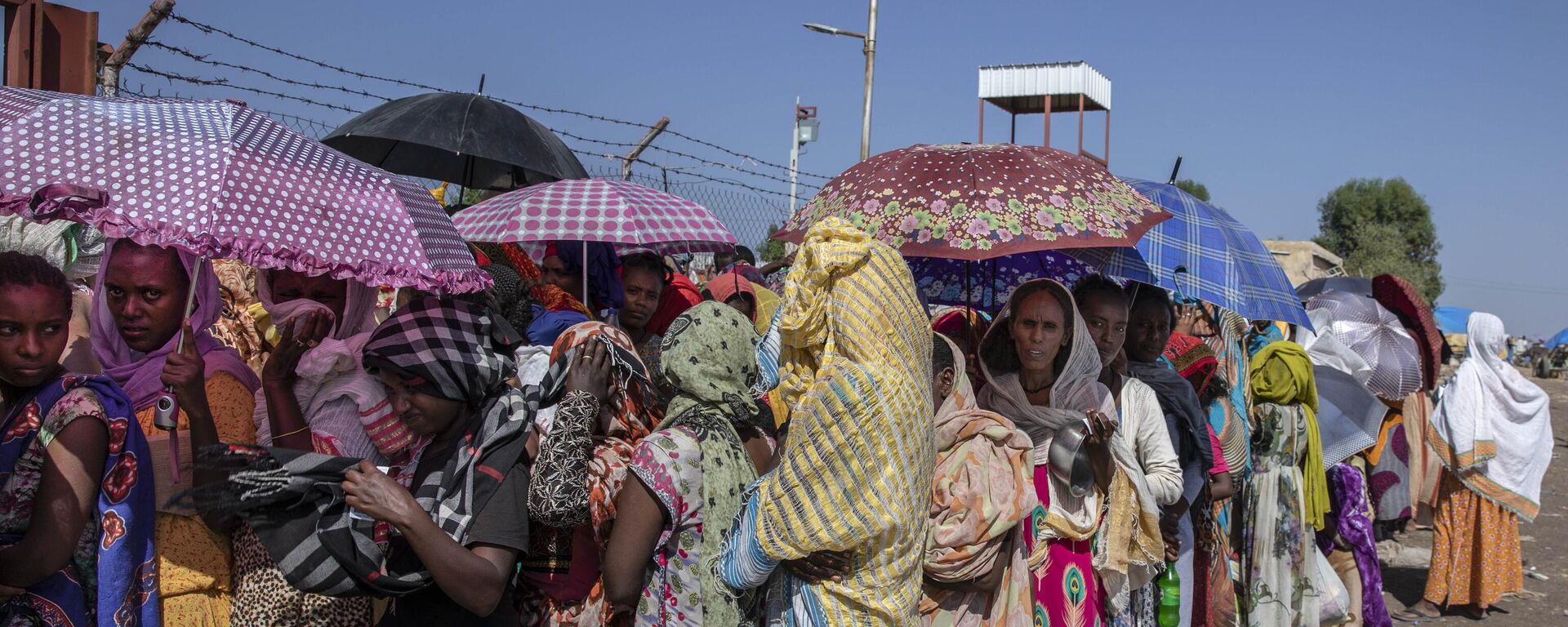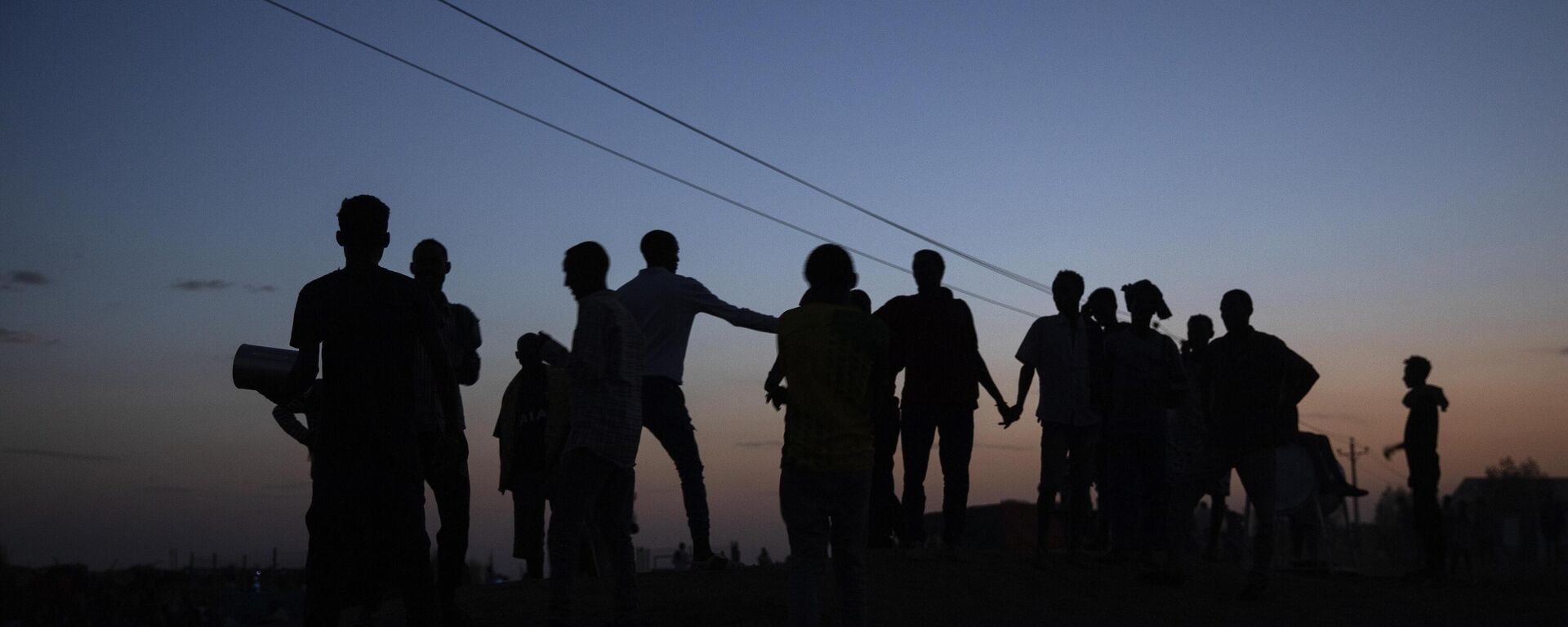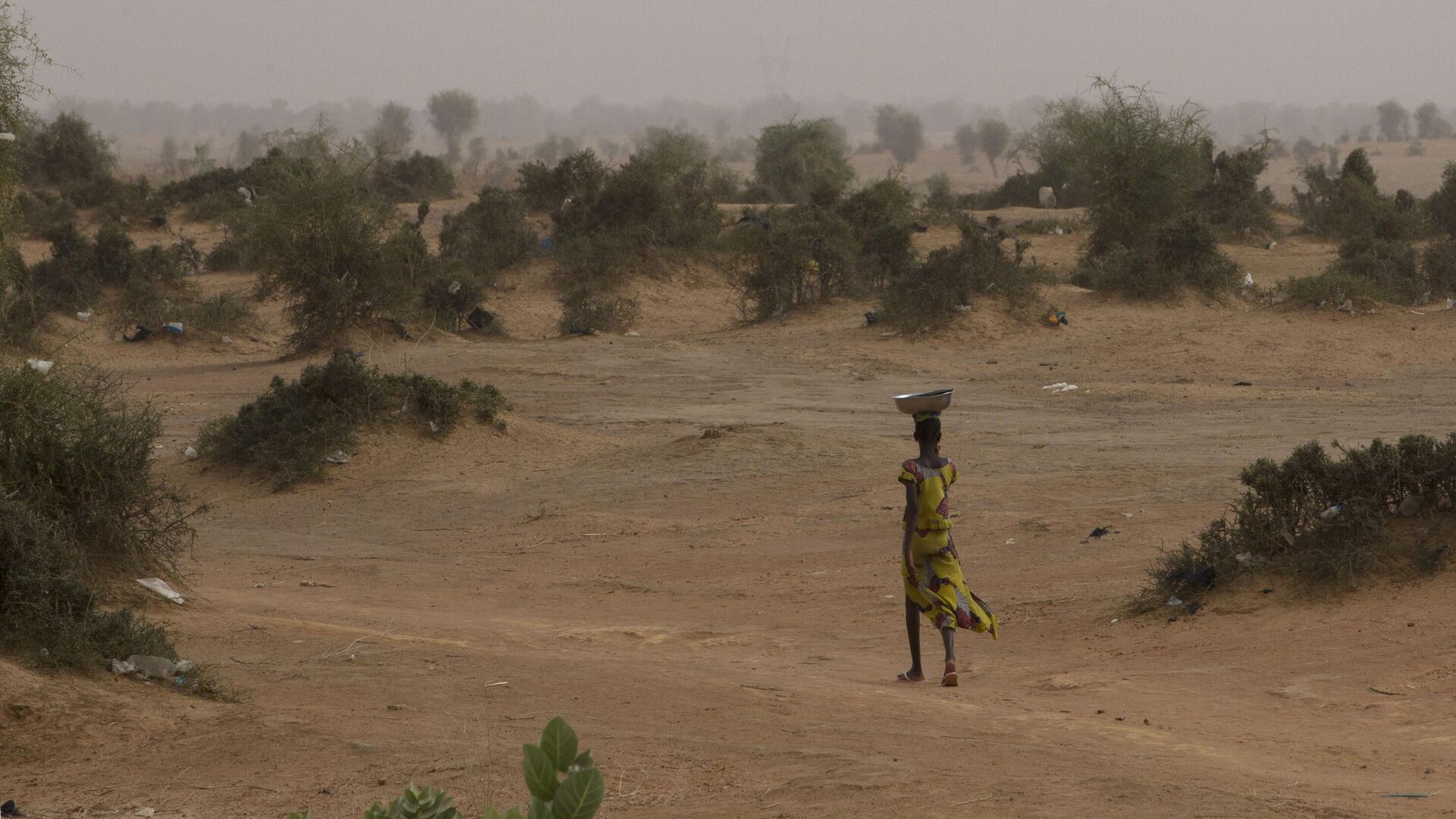https://sputnikglobe.com/20230308/five-most-severe-droughts-in-africa--1108151707.html
Five Most Severe Droughts in Africa
Five Most Severe Droughts in Africa
Sputnik International
Today's African droughts are far from the first ones to hit the continent, affecting both African nations' economies and lives of the locals. Sputnik recollects latest most severe droughts occcured on the continent.
2023-03-08T11:35+0000
2023-03-08T11:35+0000
2023-03-08T11:51+0000
africa
east africa
southern africa
horn of africa
disaster
tragedy
drought
megadroughts
https://cdn1.img.sputnikglobe.com/img/07e7/01/18/1106649025_0:382:2960:2047_1920x0_80_0_0_cea939ccb8a76b699086ee4733fd84b9.jpg
Kenya has lost about 2.61 million heads of livestock due to drought in recent months due to the worsening crisis in arid and semi-arid areas, according to a report by the country's National Drought Management Authority (NDMA). The NDMA says this is about 5% of all animals in arid and semi-arid areas, which number 52.8 million.Africa is no stranger to droughts, as they periodically occur, taking a toll on the economies of nations as well as the everyday lives of locals. Sputnik recollects the most severe droughts which have occurred in Africa during the post-independence period.1. The Sahel tragedy, 1968-1974 and 1984-1985In the late 1960s the Sahel – a strip of relatively fertile land which stretches from the Atlantic to the Red Sea south of the Sahara – was ravaged by drought. This lasted until the mid-1970s, resulting in widespread hunger which lasted until the 1980s, reports say. More than 100,000 people died, while millions were forced to depart their homes for the savannahs. The droughts of 1968-1974 and 1984-1985 were so severe that they entered the history of the African continent as the Sahel tragedy. According to observations, not a single drop of rain fell in the Sahel during these years, which led to a sharp decrease in the groundwater level. As a result, the surface flow of large rivers was halved, small rivers dried up, and the area of Lake Chad decreased by 90%, studies show. Fertile areas of pastures disappeared, and livestock left without food began to die. As a consequence, a famine began, which claimed a total of about 2 million human lives, according to some studies. To stop the massive loss of livestock, nomads had to cut down trees and feed the animals their foliage. By depleting the woody vegetation, pastoralists eliminated the only obstacle to the expansion of the desert and further damaged the ecology.According to the same research, after the devastating drought of 1968-1974, the world community took urgent steps to prevent the occurrence of an environmental disaster in the Sahel.As one of the measures, the UN launched an international project involving the protection and effective use of natural forage lands, as well as took steps to improve methods of cattle breeding and agriculture, planting a green strip in the north of the Sahel.After the drought of 1984-1985, the UN developed its "Action Program for the Economic Development and Reconstruction of Africa". 2. The Great Ethiopian Famine, 1983-1985The 1983-1985 famine in Ethiopia (also known as the Great Ethiopian Famine) was caused by drought and affected the territories of modern Eritrea and Ethiopia. This mass famine was the largest to strike the country in the 20th century. In northern Ethiopia, the famine resulted in more than 400,000 deaths. The tragedy was triggered by dry spells in the country and was aggravated by regional restrictions on trade and the movement of local subsistence farmers.At the initiative of Irish musician Bob Geldof, who witnessed the Ethiopian tragedy himself, a Live Aid charity concert was organized at Wembley Stadium in London in July 1985, which gathered more than 70,000 spectators and more than a billion people of the television audience. On the same day, a similar concert was held in Philadelphia in the USA with the participation of Madonna, Led Zeppelin, Duran Duran, Bob Dylan and other American stars.Moreover, such famous musicians as Stevie Wonder, Diana Ross, Tina Turner, Michael Jackson, Lionel Richie, Bob Dylan and many other American singers took part in the formation of the "USA for Africa" group, which recorded the song "We are the World", which became very famous. Both Western countries and the USSR provided help for Ethiopia. The country receieved humanitarian aid and logistical support. Soviet transport detachments, military advisers and translators participated in the delivery of bread to the hungry.3. Drought in the Horn of Africa, 2011 Millions of people on the Somali peninsula (Horn of Africa) – from Somalia, Djibouti, Ethiopia, Eritrea, Kenya and eastern Uganda – have been affected by the devastating drought in the region in 2011, according to the UN Office for the Coordination of Humanitarian Operations.More than 10 million people were affected by the drought to one degree or another, said an official representative of the organization.Some of the regions suffered from famine, which was brought about by highly dry weathers, the UN said, noting that Kenya, Ethiopia, and Somalia were the hardest to be hit. According to the organization, the lack of precipitation led to a serious food crisis. According to the UN estimations, more than 250,000 people died in the famine in Somali peninsula between October 2010 and April 2012.4. Drought in the Sahel, 2012The droughts of 2005, 2008 and 2010 brought considerable disasters to the Sahel region, from Eritrea to Mauritania, according to UN reports. The following, relatively prosperous year (2011) allowed local subsistence farmers only a little time to catch their breath. Mali, Niger and parts of Chad were affected by the drought in 2012, and the subsequent food crisis hit the entire region. In 2012, the UN asked donors to allocate $720 million to help those affected by drought. The press secretary of the UN Office for the Coordination of Humanitarian Affairs, Jens Lerke, spoke about the needs of the region, as well as financial support.Compared to 2011, Mauritania and Chad recorded a decrease in yields of more than 50%. Food supplies in the affected areas were very small, and corn prices increased by 60-85% compared to the average over the previous five years. In Chad alone, the food crisis affected the lives of about 3.6 million people, studies show.According to UN estimations, in Burkina Faso and in Senegal more than 2.8 million and 800,000 people respectively were suffering from hunger.5. Drought in southern Africa, 2015 – current times Catastrophically little precipitation has fallen in southern Africa for seven years in a row, records show. According to surveys, every spring (which comes to southern Africa in August), tens of millions of people from 16 countries in the region face the threat of famine. For South Africa, which is the main grain-growing region of southern Africa, 2015 was the driest year in history, jeopardizing the corn harvest and provoking an increase in spot grain prices by 100 percent for the year, some surveys say.According to the UN World Food Program (WFP), rainfalls in many parts of the region between October 2015 and January 2016 were the lowest in 35 years. The drought has also had a negative impact on cattle breeding, the main source of income for many rural farms in the region. It is important to note that the drought had been worsened due to the El Nino weather phenomenon, according to a WFP report. El Nino is a process where the water surface warms up in the western and central Pacific Ocean, affecting weather patterns; it occurs every few years and leads to torrential rains and floods in South America, as well as hot weather in Asia and Africa.***According to UN reports, droughts disproportionately affect poor and socially disadvantaged segments of the world's population, for whom the price of drought is measured in lives, livelihoods and impoverishment. Dry weather can not only significantly affect national economies, but also result in crop failures, livestock deaths, mass migration, famine and health consequences, as well as disruptions in the supply of food and the functioning of markets, the organization states.Climate change is becoming an increasingly powerful factor contributing to the occurrence of drought. This phenomenon intensifies the consequences and increases the frequency, intensity and duration of droughts in many regions of the world, states the United Nations. In the absence of adequate management, drought is one of the factors of desertification and land degradation, which increases the fragility of ecosystems and social instability, especially in rural communities, outlines the organization. Despite being one of the lowest contributors to global greenhouse gas emissions, Africa is one of the regions most affected by climate change effects, such as drought, floods and wildfires, says the UN.
https://sputnikglobe.com/20230223/unhcr-says-attention-to-humanitarian-matters-in-africa-not-adequate---special-envoy-1107752491.html
https://sputnikglobe.com/20230306/malawi-praises-first-fertilizer-shipment-from-russia-as-essential-for-tackling-food-crisis-1108083762.html
https://sputnikglobe.com/20230222/the-five-severest-migration-crises-in-the-history-of-africa-1107668291.html
https://sputnikglobe.com/20230307/europe-uses-grain-deal-to-profiteer-from-africa-expert-says-1108137213.html
africa
east africa
southern africa
horn of africa
Sputnik International
feedback@sputniknews.com
+74956456601
MIA „Rosiya Segodnya“
2023
News
en_EN
Sputnik International
feedback@sputniknews.com
+74956456601
MIA „Rosiya Segodnya“
Sputnik International
feedback@sputniknews.com
+74956456601
MIA „Rosiya Segodnya“
african droughts, climate change, africa struggle, death poll, droughts victims, lack of water, dry spells
african droughts, climate change, africa struggle, death poll, droughts victims, lack of water, dry spells
Five Most Severe Droughts in Africa
11:35 GMT 08.03.2023 (Updated: 11:51 GMT 08.03.2023) Climate change is becoming a more and more significant culprit in the occurence of droughts, according to the United Nations. It intensifies the consequences and increases the frequency, severity and duration of droughts in many regions. Africa is one of the hardest hit parts of the world.
Kenya has lost about 2.61 million heads of livestock due to drought in recent months due to the worsening crisis in arid and semi-arid areas, according to a report by the country's National Drought Management Authority (NDMA). The NDMA says this is about 5% of all animals in arid and semi-arid areas, which number 52.8 million.
Africa is no stranger to droughts, as they periodically occur,
taking a toll on the economies of nations as well as the everyday lives of locals.
Sputnik recollects the most severe droughts which have occurred in Africa during the post-independence period.
1. The Sahel tragedy, 1968-1974 and 1984-1985
In the late 1960s the Sahel – a strip of relatively fertile land which stretches from the Atlantic to the Red Sea south of the Sahara – was ravaged by drought. This lasted until the mid-1970s, resulting in widespread hunger which lasted until the 1980s, reports say. More than 100,000 people died, while millions were forced to depart their homes for the savannahs.
The droughts of 1968-1974 and 1984-1985 were so severe that they entered the history of the African continent as the
Sahel tragedy. According to observations, not a single drop of
rain fell in the Sahel during these years, which led to a sharp decrease in the groundwater level. As a result, the surface flow of large rivers was halved, small rivers dried up, and the area of Lake Chad decreased by 90%, studies show. Fertile areas of pastures disappeared, and livestock left without food began to die.
As a consequence, a famine began, which claimed a total of about 2 million human lives, according to some studies. To stop the massive loss of livestock, nomads had to cut down trees and feed the animals their foliage. By depleting the woody vegetation, pastoralists eliminated the only obstacle to the expansion of the desert and further damaged the ecology.
According to the same research, after the devastating drought of 1968-1974, the world community took urgent steps to prevent the occurrence of an environmental disaster in the Sahel.
As one of the measures, the UN launched an international project involving the protection and effective use of natural forage lands, as well as took steps to improve methods of cattle breeding and agriculture, planting a green strip in the north of the Sahel.
After the drought of 1984-1985, the UN developed its "Action Program for the Economic Development and Reconstruction of Africa".

23 February 2023, 22:18 GMT
2. The Great Ethiopian Famine, 1983-1985
The 1983-1985 famine in Ethiopia (also known as the Great Ethiopian Famine) was caused by drought and affected the territories of modern Eritrea and Ethiopia. This mass famine was the largest to strike the country in the 20th century. In northern Ethiopia, the famine resulted in more than 400,000 deaths. The tragedy was triggered by dry spells in the country and was aggravated by regional restrictions on trade and the movement of local subsistence farmers.
At the initiative of Irish musician Bob Geldof, who witnessed the Ethiopian tragedy himself, a
Live Aid charity concert was organized at Wembley Stadium in London in July 1985, which gathered more than 70,000 spectators and more than a billion people of the television audience. On the same day, a similar concert was held in Philadelphia in the USA with the participation of Madonna, Led Zeppelin, Duran Duran, Bob Dylan and other American stars.
Moreover, such famous musicians as Stevie Wonder, Diana Ross, Tina Turner, Michael Jackson, Lionel Richie, Bob Dylan and many other American singers took part in the formation of the "USA for Africa" group, which recorded the song "We are the World", which became very famous.
Both Western countries and the USSR provided help for Ethiopia. The country receieved humanitarian aid and logistical support. Soviet transport detachments, military advisers and translators participated in the delivery of bread to the hungry.
3. Drought in the Horn of Africa, 2011
Millions of people on the Somali peninsula (Horn of Africa) – from Somalia, Djibouti, Ethiopia, Eritrea, Kenya and eastern Uganda – have been affected by the devastating drought in the region in 2011, according to the UN Office for the Coordination of Humanitarian Operations.
More than 10 million people were affected by the drought to one degree or another, said an official representative of the organization.
Some of the regions suffered from famine, which was brought about by highly dry weathers, the UN said, noting that Kenya, Ethiopia, and Somalia were the hardest to be hit. According to the organization, the lack of precipitation led to a serious food crisis.
According to the UN estimations, more than 250,000 people died in the famine in Somali peninsula between October 2010 and April 2012.

22 February 2023, 13:31 GMT
4. Drought in the Sahel, 2012
The droughts of 2005, 2008 and 2010
brought considerable disasters to the Sahel region, from Eritrea to Mauritania, according to UN reports. The following, relatively prosperous year (2011) allowed local subsistence farmers only a little time to catch their breath. Mali, Niger and parts of Chad were affected by the drought in 2012, and the subsequent food crisis hit the entire region.
"A family can get back on its feet after one drought, but it is very difficult to recover from three. And this is the main problem we face in this case," said David Gressley, a former UN Coordinator in the region.
In 2012, the UN asked donors to
allocate $720 million to help those affected by drought. The press secretary of the UN Office for the Coordination of Humanitarian Affairs, Jens Lerke, spoke about the needs of the region, as well as financial support.
"The new humanitarian appeals concern the provision of assistance to Burkina Faso, Mali and Mauritania. The two appeals that have been revised relate to Chad and Niger," stated the UN official. "The consolidated appeal for the entire Sahel region plus the humanitarian needs of the people of Cameroon, Gambia, Nigeria and Senegal today amounts to a total of one billion 600 million dollars."
Compared to 2011, Mauritania and Chad recorded a decrease in yields of more than 50%. Food supplies in the affected areas were very small, and corn prices increased by 60-85% compared to the average over the previous five years. In Chad alone, the food crisis affected the lives of about 3.6 million people, studies show.
According to UN estimations, in Burkina Faso and in Senegal more than 2.8 million and 800,000 people respectively were suffering from hunger.
5. Drought in southern Africa, 2015 – current times
Catastrophically
little precipitation has fallen in southern Africa for seven years in a row, records show. According to surveys, every spring (which comes to southern Africa in August), tens of millions of people from 16 countries in the region face the threat of famine.
For South Africa, which is the main grain-growing region of southern Africa, 2015 was the driest year in history, jeopardizing the corn harvest and provoking an increase in spot grain prices by 100 percent for the year, some surveys say.
According to the UN World Food Program (WFP), rainfalls in many parts of the region between October 2015 and January 2016 were the lowest in 35 years. The drought has also had a negative impact on cattle breeding, the main source of income for many rural farms in the region.
It is important to note that the drought had been worsened due to the El Nino weather phenomenon, according to a WFP report. El Nino is a process where the water surface warms up in the western and central Pacific Ocean, affecting weather patterns; it occurs every few years and leads to torrential rains and floods in South America, as well as hot weather in Asia and Africa.
According to UN reports, droughts disproportionately affect poor and socially disadvantaged segments of the world's population, for whom the price of drought is measured in lives, livelihoods and impoverishment. Dry weather can not only significantly affect national economies, but also result in crop failures, livestock deaths, mass migration, famine and health consequences, as well as disruptions in the supply of food and the functioning of markets, the organization states.
Climate change is becoming an increasingly powerful factor contributing to the occurrence of drought. This phenomenon intensifies the consequences and increases the frequency, intensity and duration of droughts in many regions of the world, states the United Nations. In the absence of adequate management, drought is one of the factors of desertification and land degradation, which increases the fragility of ecosystems and social instability, especially in rural communities, outlines the organization.
Despite being one of the lowest contributors to global greenhouse gas emissions, Africa is one of the regions most affected by climate change effects, such as drought, floods and wildfires, says the UN.








